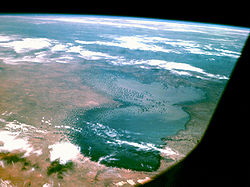Lake Chad
| Lake Chad | |
|---|---|

Photograph taken by Apollo 7, October 1968
|
|

Map of lake and surrounding region
|
|
| Coordinates | 13°0′N 14°0′E / 13.000°N 14.000°ECoordinates: 13°0′N 14°0′E / 13.000°N 14.000°E |
| Lake type | Endorheic |
| Primary inflows | Chari River |
| Primary outflows | Soro & Bodélé depressions |
| Basin countries | Chad, Cameroon, Niger, Nigeria |
| Surface area | 1,350 km2 (520 sq mi) (2005) |
| Average depth | 1.5 m (4 ft 11 in) |
| Max. depth | 11 m (36 ft) |
| Water volume | 72 km3 (17 cu mi) |
| Shore length1 | 650 km (400 mi) |
| Surface elevation | 278 to 286 metres (912 to 938 ft) |
| References | |
| 1 Shore length is not a well-defined measure. | |
Lake Chad is a historically large, shallow, endorheic lake in Africa, which has varied in size over the centuries. According to the Global Resource Information Database of the United Nations Environment Programme, it shrank by as much as 95% from about 1963 to 1998, but "the 2007 (satellite) image shows significant improvement over previous years." Lake Chad is economically important, providing water to more than 68 million people living in the four countries surrounding it (Chad, Cameroon, Niger, and Nigeria) on the edge of the Sahara Desert. It is the largest lake in the Chad Basin.
Lake Chad is mainly in the far west of Chad, bordering on northeastern Nigeria. The Chari River, fed by its tributary the Logone, provides over 90% of the lake's water, with a small amount coming from the Yobe River in Nigeria/Niger. Despite high levels of evaporation, the lake is fresh water. Over half of the lake's area is taken up by its many small islands (including the Bogomerom archipelago), reedbeds and mud banks, and a belt of swampland across the middle divides the northern and southern halves. The shorelines are largely composed of marshes.
Because Lake Chad is very shallow—only 10.5 metres (34 ft) at its deepest—its area is particularly sensitive to small changes in average depth, and consequently it also shows seasonal fluctuations in size. Lake Chad has no apparent outlet, but its waters percolate into the Soro and Bodélé depressions. The climate is dry most of the year, with moderate rainfall from July through September.
...
Wikipedia
